Portuguese Tanks & AFVs
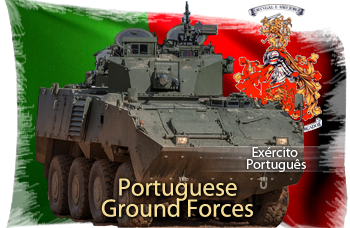
Origins
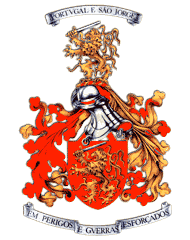 The Portuguese Army is one of the oldest in Europe, dating back from the 12th Century. The Navy would remain strongly independent until the 20th century, some common exercises being held under political coordination. Colonial Forces were also independent of the territorial Army. Various ministries were merged eventually in the 1930s, and during ww2 the need to defend the Forças Coloniais necessitated to place all available forces under the single Ministério da Guerra. On the world diplomatic scene, the oldest and most useful alliance was born from the Anglo-Portuguese Treaty of 1373.
The Portuguese Army is one of the oldest in Europe, dating back from the 12th Century. The Navy would remain strongly independent until the 20th century, some common exercises being held under political coordination. Colonial Forces were also independent of the territorial Army. Various ministries were merged eventually in the 1930s, and during ww2 the need to defend the Forças Coloniais necessitated to place all available forces under the single Ministério da Guerra. On the world diplomatic scene, the oldest and most useful alliance was born from the Anglo-Portuguese Treaty of 1373.
Portugal in WW2
Under the authoritarian regime of Salazar, March 17, 1939, saw the conclusion of a non-aggression pact with Franco's Spain whereas, in April, Portugal refused to join the anti-Comintern pact (Germany, Italy, Spain). Later on in 1940-42, both the Axis and allies had views on the Madeira and particularly the Azores to better control the Atlantic. Three operations were planned by the Germans and one allied (Operation Alacrity).On the colonial side, Portuguese Timor was provisionally seized and occupied by Australian and Dutch troops, fearing for a Japanese Invasion, which indeed took place on February 19, 1942, with 20,000 men. The capital, Dili was first occupied, then the rest of the colony which was only returned to Portugal with the surrender in September 1945.
Starting in July 1942, Portuguese JU-52 cargo trimotors did perform missions for the Axis. At the same time, Salazar was still favorable to help the British government and did as a good will gesture helped evacuate and relocate 2,500 evacuees from Gibraltar to Madeira. In 1942 Lajes Field on the Azores was used as an allied air base, flying Gloster Gladiator fighters for extended patrols, while reconnaissance missions and meteorological flights were also performed. A 1939 Military agreement with the UK was not enforced until 1943 when the Portuguese Armed Forces were seriously beefed-up by the British Government. At the end of 1943 additional bases were leased to the RAF, troops and equipment were deployed at the occasion of Operation Alactrity in order to close the Mid-Atlantic gap. It should be noticed also that Portugal and in particular Lisbon was a refuge for several thousands to one million Jews and in general populations fleeing the Occupation throughout Europe.
So what were the armored fighting vehicles in service with the Portuguese Army in ww2? Apparently Carden-Loyd tankettes, and Vickers 6-ton tanks in the 1930s, and from late 1943, Dingo scout cars and Humber ACs, and with Lend-lease, M3 and M5 half-tracks, M4 Shermans, M3 Stuarts, M8 Greyhounds, even Canadian Grizzly tanks (militaryfactory.com).
The Cold War
In 1950, the National Defense Minister and the Armed Forces Chief of the General Staff are both created (CEMGFA). The modern Forças Armadas were therefore created at that time. Under the Ministro da Defesa Nacional was created a Secretariado-Geral da Defesa Nacional or SGDN alongside the CEMGFA, and the SGDN was renamed Armed Forces General Staff in 1974. Still independent the Marinha and Exército air forces are merged in 1952 (Força Aérea). And in In 1953, the National Republican Guard became the Military Police. Two other PMs were created for the air force and navy.The 1950s, saw a deep reorganization of the military forces in Portugal. The Armed Forces were established as an integrated organization in 1950, encompassing the already existing Army and Navy (to which the newly created Air Force was added in 1952), under the overall command of the Minister of National Defense and the Chief of the General Staff of the Armed Forces. The ground forces in the Overseas were finally merged with the Metropolitan Army, with a single Portuguese Army existing from then on. The establishment of the integrated Armed Forces led to the creation of the permanent roles of commander-in-chief to serve as the unified operational commanders of all the ground, air and naval forces stationed in each of the Overseas provinces. These commanders-in-chief will soon increase their operational importance over the local service commanders, with the Army territorial commands in each province going to have mere logistical responsibilities. In the scope of the peak of the Cold War, the organization of the Portuguese Army in the Overseas was built with a concern on the imminent threat of war in Europe, compared with a perception of the existence of a low risk of conflicts in the Overseas provinces themselves. So, the Overseas forces were re-organized going from a focus on the internal security to a focus on the conventional warfare, at the same time being oriented to be able to reinforce the Army in Europe and not the opposite. As part of these, the previous military organization based in small company-sized units scattered along the territory was replaced by an organization based in battalion and even regiment-sized units concentrated in the main cities. In Angola and Mozambique, this structure was designed to allow the raising of entire field divisions to be deployed to European Portugal in case of a conventional warfare with the Warsaw Pact.
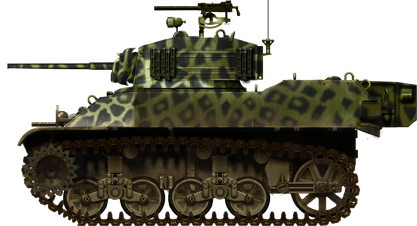
Portuguese M5 Stuart in Angola, 1967.
The Colonial Wars (1961-1974)
The Guerra do Ultramar (overseas wars) would take a major part of the Cold War Portuguese Army occupation and triggered modernization and organizational changes. These took 13 years of protracted asymmetrical warfare in the Portuguese African provinces. As part of a more generic east-west checkerboard play, decisive ideological struggle often saw NATO-aligned Portuguese forces dealing with communist-backed movements. The latter were amalgamated under the CONCP umbrella, but the Portuguese had some local help from pro US groups.But the first blow was given by... Indian troops, in fact reclaiming parts of their territory still held by Portugal. Faced by overwhelmingly superior forces, the four garrisons quickly surrendered. After that, attention focused back to Africa through the Angola (1961-1974), Portuguese Guinea (1963-1974) and Mozambique (1964-1974) wars.
The bulk of these forces were organized into light infantry companies of caçadores better tailored for the task of counter-insurgency and deployed in grids (quadrícula). More rarely they were backed by larger regimental-level battle groups (agrupamentos) for major operations. These included artillery, genie, and armored components among others. Special Forces were also raised, called Special Caçadores companies with selected personal, later sometimes called "commandos". It should be noted that one of these units, organically well-equipped and fully autonomous gained fame in Angola, called the "dragons".
Despite the odds of having well-backed opponents by the Warsaw pact and to manage three fronts one a distant theater from the metropolis was quite an achievement until the war was put to an end after the Carnation Revolution military coup of 25 April 1974 in Lisbon. Subsequently, all former African Portuguese colonies became independent.
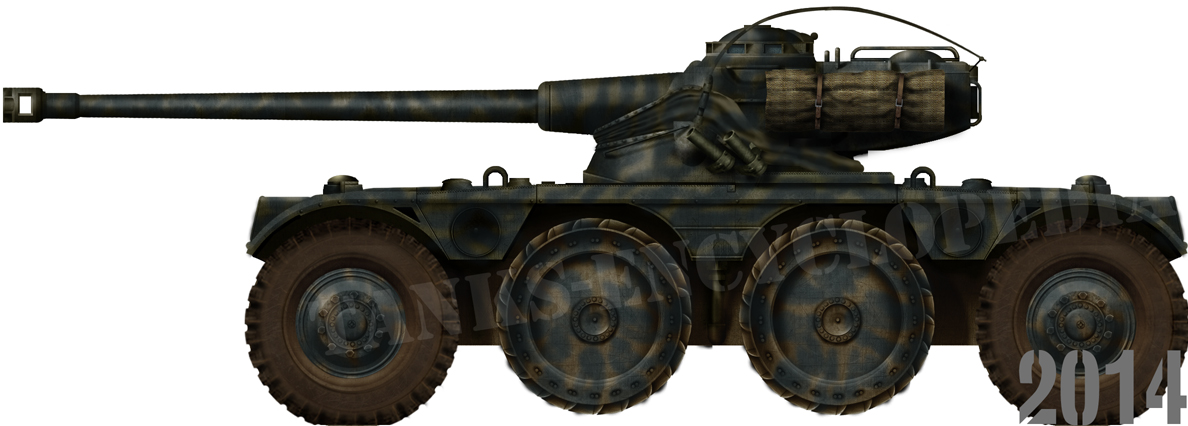
Panhard EBR-75 of the Dragoes de Angola
AFVs operating in the cold war
One of the earliest light tanks in service were surplus M24 Chaffee. US-supplied tanks later were of the M47 Patton, M48 Patton and eventually M60 type (still in service for the latter), Daimler Ferret, Alvis Saladin, Panhard EBR and AMLs and the generic APC Mercedes-Benz Unimog. In the 1960s other vehicles were procured like the M151 Mutt Jeep, CGC M706 -which influenced the only national AC at that time, the Bravia Chaimite- and miscellaneous vehicles derived from the M113 (and the M113 too), like the M163 SPAAG, M730 Chapparal SPAAML, M901 ITV, but also the M88 Hercules ARV, and M109 SPG.The Portuguese at war (Macao and Angola)

India:
In December 1961, small garrisons of the Portuguese Army in Portuguese India (Macao) faced a massive Indian invasion, supported by air and naval forces. Resistance was brief but hopeless, and the isolated Portuguese garrisons of Goa, Daman, Diu and Angidiva island surrendered. This ended hundreds of years of Portuguese presence in India. This topic is of little interest for us, as the Portuguese garrisons had only softskin vehicles, like Jeeps and trucks.Africa
In Africa, the Portuguese Army started a long and protracted counterinsurgency campaign, against separatists. These "dirty" colonial wars were called the "Overseas War". But three very different theatres of operations in Africa were concerned, stetching the Portuguese army to the brink. These were the wars of Angola (1961-1974), Portuguese Guinea (1963-1974) and Mozambique (1964-1974). The Portuguese faced these forces with almost no external support while opposing forces were massively supported by the Warsaw Pact, or even some Western European countries. Despite of all odds, these three campaigns spanned for 13 years and the solution was not military but political. These counterinsurgency campaigns had various degrees of success, the Portuguese nearly reaching all their objectives an destroying all opposition in Angola, but it ended as a stalemate in Mozambique and a while it became an almost conventional conflict in Portuguese Guinea, and nearly ended in a disaster. The Carnation Revolution military coup of 25 April 1974 in Lisbon put an end to these operations, granting independence to these overseas provinces.In the early 1960s, however, there was already a perception that guerrilla type conflicts would erupt in some of the Portuguese African territories, leading the Portuguese Army to re-orient its strategy and reorganize its forces in the Overseas, at the same type preparing its forces in Europe to be able reinforce the Overseas. As part of this, the 9th Infantry Regiment in Lamego was transformed in the Special Operations Training Centre, intended to provide counter insurgency and guerrilla warfare training. The Army territorial organization that was implemented when the Overseas war erupted, divided the Portuguese national territory (Metropolitan and Overseas) in military regions (that could be subdivided in territorial commands) and in independent territorial commands. Angola and Mozambique constituted military regions commanded by generals, subdivided in territorial commands, while the other Overseas provinces - including Portuguese Guinea - constituted independent territorial commands (The exception was São Tomé and Príncipe which constituted a territorial command of the Angolan military region, until becoming an independent command in 1962). The Overseas military regions and territorial commands included units of the normal garrison (regiments, battalions and others), which constituted the permanent territorial administrative bodies responsible for the mobilization and preparation of active troops.
The active troops themselves were organized in formations and units raised by the normal garrison units. Besides the local raised active units, many of these were raised by the European Portuguese regiments and deployed to the Overseas, being referred as "reinforcement units". The active units were temporary units - mainly formed with conscripts framed by a small cadre of career officers and NCOs - that existed only during the tour of duty or active military service period of their elements (usually two years). When their period of existence was near the end, these units were replaced in the field by newly raised similar units, then returning to their parent regiment's barracks, where they were formally disbanded, their conscripts being licensed and their career elements being transferred to other units. The majority of active units employed in the Overseas War were light infantry units, designed for the counterinsurgency role, designated as caçadores (similar units raised by cavalry and artillery regiments had the designation of their respective branches, although trained, equipped and organized as caçadores). These were organized in companies of caçadores that could be independent or be grouped in battalions of caçadores. Besides the caçadores units, the Portuguese Army also raised and fielded regimental-level battlegroups (agrupamentos) headquarters and a number of specialized units (including units of field artillery, anti-aircraft artillery, armored reconnaissance, military police, engineering, signals, mortars, recoilless guns and combat support services). The Army also raised special forces and was involved in the organization of a number of irregular forces. The Army's special forces in the initial stages of the War were the Special Caçadores companies, raised by the 5th (Lisbon) and 10th (Chaves) Caçadores battalions, with specially selected personnel that then received their training in the Special Operations Training Centre. The Army lobby against the special forces prevailed however, with these units ceasing to be raised in 1962, with the intention that all normal caçadores units would receive the same training as the disbanded special caçadores. However, this proved infeasible and the lack of special forces made quickly felt, with some units mitigating this issue by raising informal special forces sub-units with selected personnel, with some of these being referred as "commandos". The Commandos would soon be formalized in Angola and then in the other theatres. From 1966, a special anti-guerrilla horse unit (the Angola Dragoons) also existed.
The majority of the caçadores units were deployed in grid (quadrícula), being scattered through the theatres, with each unit being responsible for the counterinsurgency activities in a given area of responsibility. Usually a caçadores battalion was responsible for a sector, having its companies disperse through the sector, each one being responsible for its own sub-sector. Sometimes, several battalion sectors were grouped in a larger battlegroup area of responsibility. The grid units were often reinforced with artillery, armored reconnaissance and other types of units. Besides the grid units, there were also the intervention forces that were held in reserve by the commands to intervene in any part of the theaters, usually in offensive operations or in the temporary reinforcement of grid units under heavy attack. Most of the intervention forces were units of special forces, but some selected caçadores units also served in this role. By 1974, as active units in the field, the Army had six Commando companies, eight battlegroup headquarters, 35 caçadores battalions headquarters and 180 caçadores companies in the Angolan theatre, one Commando battalion, four battlegroup headquarters, 18 caçadores battalion headquarters and 80 caçadores companies in the Guinean theatre and one Commando battalion, four battlegroups headquarters, 28 caçadores battalions headquarters and 120 caçadores companies in the Mozambican theatre, besides a number of active units of artillery, armor, engineering and other branches, units of normal garrison units and of other bodies.
Late cold war reforms
After the independence of most of the Portuguese overseas territories in the 1974–1975 period and after 500 years of being a multi-continental country, Portugal became again mainly confined to its European territory. After the end of the political instability period that followed the Carnation Revolution and the tutelage of the Armed Forces over the new regime, the Portuguese Army returned to the barracks and began the process of changing from an oversized colonial and counter-insurgency army to a conventional European army, including drastic personnel reductions, disbanding of some units, acquisition of new arms and equipment, reorganizing units and roles and fielding new headquarters. In the late 1970s and in the 1980s, the main concern of the Army became again the possible conflict with the Warsaw Pact in Europe, in the scope of the latest period of the Cold War. The Army continued to be mainly staffed with conscripts, framed by a core of professional officers and NCOs.
The Army kept the previous basic administrative and territorial organization. The Army Ministry was formally disbanded in 1974, but its structure continued to exist, with some adjustments, under the management of the Chief of Staff of the Army, who gained the status of minister. The Army and the other branches of the Armed Forces would only be administratively integrated in the new Ministry of National Defense after 1982. The territory of Continental Portugal continued to be divided in military regions, with the Azores and Madeira territorial independent commands now being designated "military zones". The regiments and other territorial units ceased to be numbered and became again designated by the place where they had their garrison. The traditional designation caçadores disappeared, with the battalions of that type being either disbanded or transformed in infantry units. Most of the Army regiments continued to be maintained in cadre strength, usually including three battalions (service, training and operational), with their main role being the annual training of conscripts. Each military region was now responsible to raise a territorial defense brigade and each military zone a territorial defense battle group. These territorial defense formations had a core of units permanently raised, but would only be fully completed through mobilization in case of war. The main operational formation was now the new 1st Independent Composite Brigade, a mixed mechanized and motorized infantry force, based in the Santa Margarida Military Camp, maintained in a high state of readiness with most of its units permanently raised. This formation was intended to be an expeditionary force, replacing the old Nun'Álvares Division as the main contribution of the Portuguese Army for the NATO ground forces. In 1986, the Special Forces Brigade was also raised as a formation kept in a high state of readiness. This was a light infantry formation, having two battalions of Commandos as its core units. The early 1980s see the Special Operations Training Center raising its own special operations unit, which becomes the second type of Army special forces, after the already existing Commandos.

M109 of the mechanized artilery at exercise Trident Juncture
1980 reforms
The Portuguese Army maintained two distinct structures, with a base Structure called Estrutura Base do Exército (EBE) including depot units regiments, centers and schools which were to train, arm and support troops, and maintain military infrastructure and support also for the the civilian population during emergencies. The Permanent Operational Force of the Army (Força Operacional Permanente do Exército) comprised the operational units of the Army, basically the active spearpoint of the whole army. By the late 1980s, two brigades were directly responsible to the Army Staff, 1st Independent Mixed Brigade (1978) and Special Forces Brigade (1984) based upon the mechanised Commando Regiment and four military regions, plus two overseas military zones.The 1st Independent Mixed Brigade comprised, four what we are concerned, of just one Armoured Battalion, a Mechanized Infantry Battalion, but also two Motorized Infantry Battalion, mostly using softskin vehicle, but also a Cavalry Reconnaissance Squadron, an Armoured Combat Engineer Company for support, a Self-Propelled Anti-Aircraft Company and a Self-Propelled Surface-to-Air-Missile Company for cover, aLlght Surfact-to-Air Missile Company and a mixed Field Artillery Battalion (towed). The organic Special Forces Brigade (Brigada de Forças Especiais) was based in Lamego, in addition to a Commando Regiment (Regimento de Comandos) at Amadora. In addition, the infantry was distributed among the four military regions, North, South, center and Lisbon military region, each with about 2-4 infantry regiments and artillery/supply units and cavalry. Cavalry units operated armoured cars, notably the Bravia Chaimite and US V-150.
Links/sources
The Guerra Ultramar The Portuguese Army (wikipedia)Portuguese cold war Army
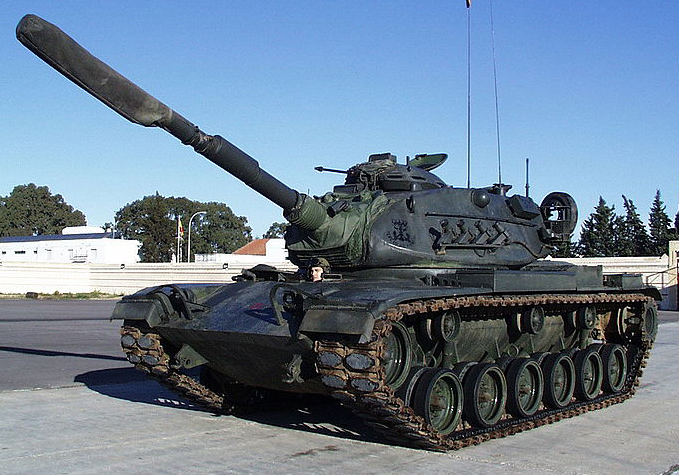
M60A3 TTS
96 "Carro de combate 51 ton 105 mm m/92" of which 14 are in 1st combat squadron and the others in reserve.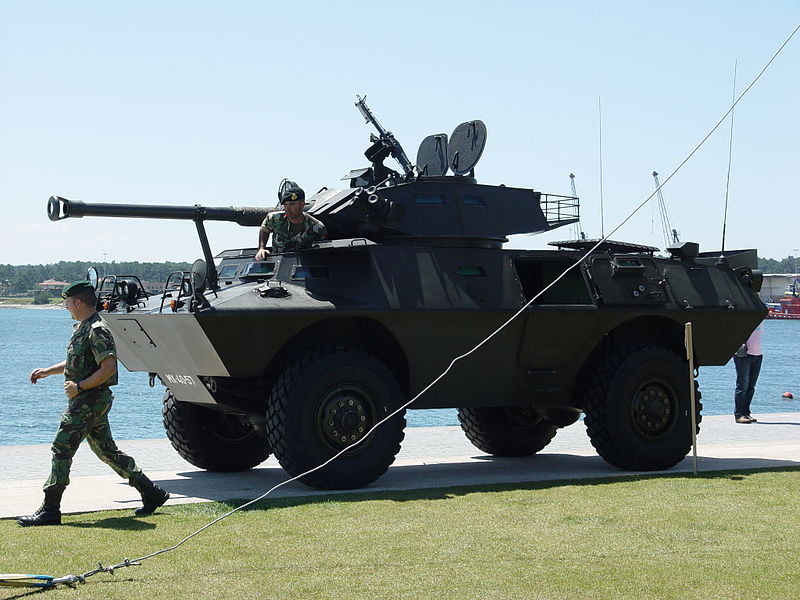
CGC V-150
Commando M706, called m/89.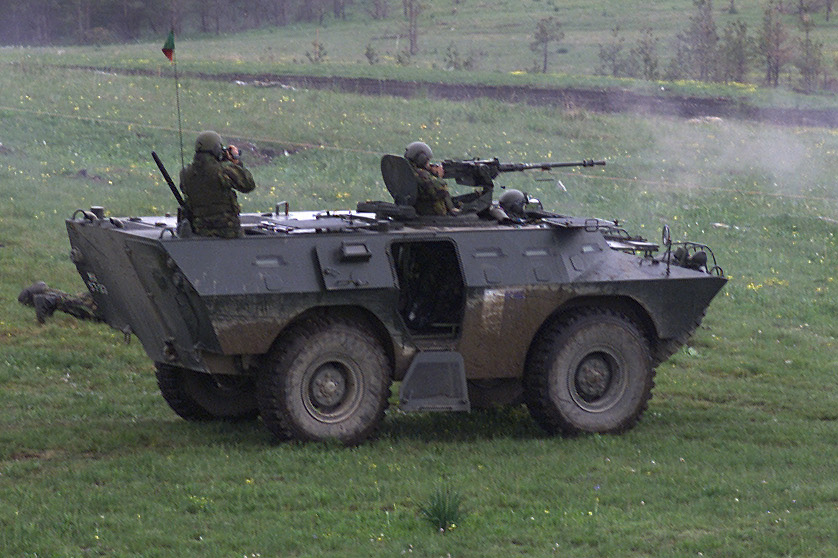
A Portuguese Chaimite V200 Armored Personnel Carrier (APC) outfitted with a 50 caliber machine gun engages a large rectangular target some two kilometers down range during Iberian Resolve, a combined live-fire exercise conducted on Western Bosnia's Glamoc live-fire range. Working in concert with the Portuguese ground forces, a pair of U.S. Army OH-58D Kiowa Warrior light attack helicopters provide reconnaissance and light fire capability, June 2, 2002. The objective of Iberian Resolve is to integrate Multinational Division OPRES Ground forces from the Portuguese 2nd Armored Division and OPRES Air Forces from the U.S. Army's 1-25 Aviation into a combined live fire exercise. (U.S. Air Force photo by Master Sgt. Scott Wagers) (Released)
Featured: Bravia Chaimite
Chaimite V200 APC, 80 in service (out of 800+)as of today.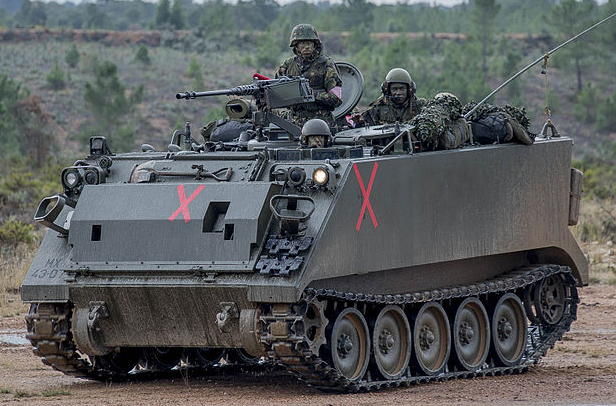
M113
M113 APC, still 227 in service.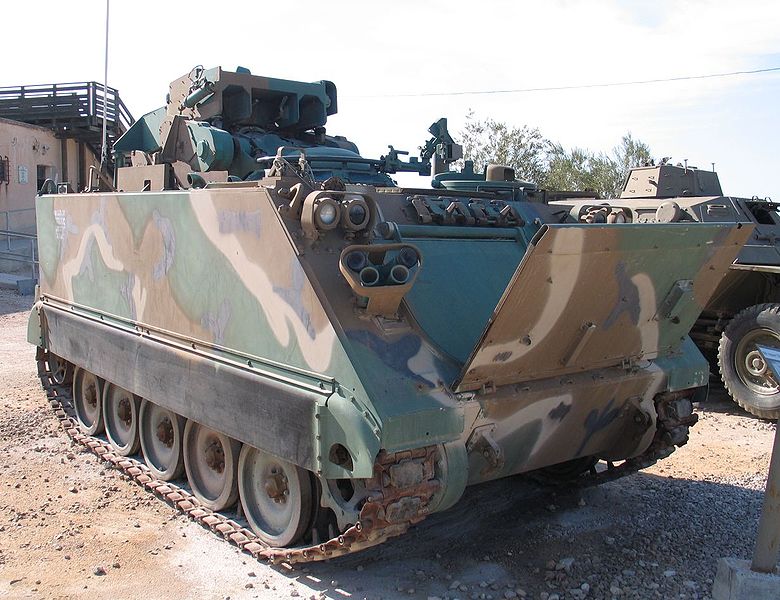
M901
M901 Tank Destroyer (4 in service)
Cold War Tanks


































Cold war tanks posters

Cold War Main Battle Tanks

Cold War Soviet Army
